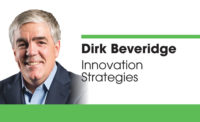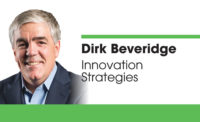Four practices to start a new vision
Time for you to change.

When we change our frame of reference, when we inject new thinking, when we question current assumptions and world views, when we cast a new vision, anything is possible, including creating completely new customer experiences.
When Howard Schultz was overseas in Europe and saw how cafes were central to Europeans’ days, he was able to craft a new vision. That vision was not to open up a coffee shop, but to create a third place in our daily lives. We have home, we have work and today we have Starbucks because anything is possible.
Here are four practices to change your frame of reference in order to cast a new vision.
Humble and hungry: The most innovative, most visionary and boldest thinkers I know are both humble and hungry. They are hungry, want growth, want to achieve excellence and want to achieve dominance. They often are pleased, but they’re never satisfied. They’re hungry, but at the same time, they’re humble. The best innovators I know have a strong point of view that more is possible. They can achieve what we have not yet achieved. They have a strong point of view that we can be better and we can innovate, but they know they’re missing something. They know that they don’t have all the answers.
Look outside your industry: I believe those of us in distribution have been incestuous. For years, we’ve hung out with the same type of businesses, with the same organizations and with the same relationships we’ve had. The solutions to the significant opportunities and challenges we face in distribution will not be found within distribution. We are good in distribution, but there’s an entire world of innovators outside our circle. There are entire new business models and cultures being developed outside our world. Innovators are going to look outside their immediate circle to find those new ideas to bring into organizations.
Move beyond your network: We must meet new people, we must expand who it is we’re learning from beyond that close-knit group or close-knit relationship we’ve had — what we’ve, quite frankly, built our career on. What we’ve done over the years is good, but it can be better. What we’ve done with our network within the industry is to learn new best practices and run back to the organization and begin implementing.
What that does is drives parity and sameness in the industry. Innovators aren’t satisfied with parity. Innovators are not satisfied with sameness. They need to break through. How do we break through? We expand our network because when we get outside our current network of relationships, we’re going to find not the next best practice circulating within our line of trade, but we’re going to find the next new idea. We’ll find the next practice.
Explore the future: We must explore the future. We must peer into the future to see where the market, where the business, where the economy and where the industry is heading to ensure we are ahead of that curve. If we need to drive change transformation within our business, remember 85% of us believe we’re operating from an outdated business model and 72% of us believe the pace of change is too slow in our organizations.
We can trace these data points back to the void of vision within our organizations. Without vision, there is no innovation. Vision is a future reality we believe is possible with committed effort. It’s peering into the future. It says, “Here’s where we’re at today as an organization. Here’s our core competency. Here’s what we do very well. Here’s what’s driving our profitability. Here’s what’s creating satisfied customers.”
We know the world is changing. We know the disruptive natures out there. We know the future is going to be different, which means our businesses will and must be different in the future.
This article was originally titled “Time for you to change” in the November 2016 print edition of Supply House Times.
Looking for a reprint of this article?
From high-res PDFs to custom plaques, order your copy today!









